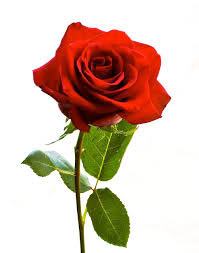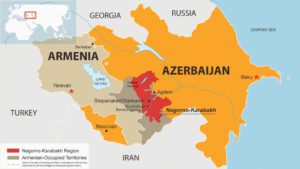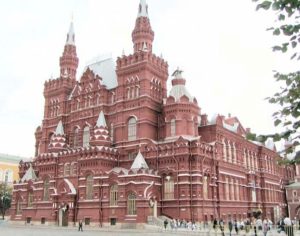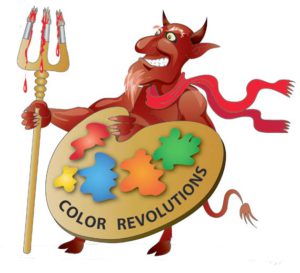 … that which we call a rose
… that which we call a rose
By any other name would smell as sweet…
On this point I would disagree with Juliet. If, rather than ‘rose’ the flower were called, say, ‘globularia’, the perfume would be the same, but the overall effect wouldn’t. For in ‘rose’ the initial ‘r’ trembles softly on the palate while being uttered, unconsciously suggesting the presence, in the rose, of the mysterious power of beauty, which “doth of itself persuade the eyes of men without an orator” (1)
Equally, Juliet’s longing expressed in the line, “O Romeo, Romeo! wherefore art thou?” (2) would lose much of its pathos, if instead of a Romeo he had been a Caruthers, or similar other name.
To trigger these remarkably idle thoughts was the news, barely mentioned in the mainstream media, of the renewed hostilities between Azerbaijan and the Armenian enclave of Nagorno-Karabakh, to which I will return later.
Some places may operate upon our mind in an uncommon manner. For a man from New York is a Newyorker, from Paris a Parisian, from Italy an Italian, but how would a man from Nagorno-Karabakh define himself? A Nagorno-Karabakhian? Possibly, though we would sense, in the sound, a euphonic discordance bordering on the jocular.
Yet, just as “there is a divinity that shapes our ends, rough hew them how we will,” (3) circumstances have made it so that there is something of a Nagorno-Karabakhian in all of us, at least in those whose skin is white or nearly so – as I will attempt to illustrate.
 Everyone who has filled an employment form, or similar, will have marked out the square corresponding to his ethnicity. For the whites, the square to mark says, ‘Caucasian.’
Everyone who has filled an employment form, or similar, will have marked out the square corresponding to his ethnicity. For the whites, the square to mark says, ‘Caucasian.’
Why should the Caucasus be the origin of the white species and not, for example, Ireland, or Finland or Estonia etc. As “there is a history in all men’s lives, figuring the nature of the times deceased…” (4) so it is with names.
In the instance, the Caucasian origin of whites has little to do with evidence and all to do with the imagination of the inevitable German professor, who made his remarkable discovery just before the French Revolution of 1789.
His name was Christoph Meiner and he explained his theories in a treatise titled, “The Outline of the History of Mankind.” In his book Meiner introduced the idea of a Caucasian race and proposed a division of human beings in two races, Caucasians and Mongolians.
But why Caucasian and why Caucasus? Because Meiner considered the people of this region to be the proto-whites, those with “the whitest, most blooming and most delicate skin.”
Starting from these conclusions, the professor explained that Caucasians are more physically attractive than Mongolians, due to their paler skin.
Shakespeare would say, “‘T is beauty truly blent, whose red and white, nature’s own sweet and cunning hand laid on.” (5) Though, in fairness, Shakespeare also has Biron say of his beautiful dark-skinned girlfriend Rosaline, “Is ebony like her? O wood divine!” (6)
But Meiner went further. Caucasians were also more sensitive and more morally virtuous than Mongolians. A truly questionable observation, particularly when considering today’s status and culture of some mostly Caucasian countries, which shall remain un-cited.
Nor did Meiner stop here. Not all Caucasians are created equal. The German Caucasians, according to the unbiased opinion of Prof. Meiner, were the most attractive and morally virtuous among the Caucasians.
This general ‘Caucasian’ theory was born not in the field but in the mind of Prof. Meiner – that is, it was not scientific in the general acception of the word. But, as we know, fanciful and exotic histories easily gain credit.
To clothe Meiner’s theories with the mantle of science was another German Professor, Johan Blumenbach, in the 1790s. How? He discovered a skull in the Caucasus, more or less by today’s Nagorno-Karabakh, which skull fitted the taxonomy of a proto-Caucasian man.
Meiner’s intuition and Blumenbach’s discovery are then the reason why we pencil ‘Caucasian’ on the application forms. Or, as the two archbishops concur in Henry V, “… the art and practic part of life must be the mistress to this theoric.” (7)
Which is also why, in the end, just like the lunatic, the lover and the poet do, Prof. Meiner’s imagination bodied forth the forms of things unknown and gave to airy nothing a local habitation and a name. (8)
I could further irritate my German (and non-German) readers if I said that Meiner defined the white, non-German Europeans as “dirty whites.” If it can be any consolation, in the first part of the XIX century an Italian philosopher called Vincenzo Gioberti wrote a book called “The moral and civil primacy of the Italians.” When first becoming aware of the book, most Italians cannot repress their laughter.
Still, how could a country, a republic, a territory, an enclave be called “Nagorno-Karabakh”? The name tells its history. “Nagorno” is a Russian adjective meaning ‘highland’. Indeed the republic covers the Southeastern section of the Lower Caucasus mountain range. ‘Karabackh” is the compound of two words, “kara” (from the Turkish, meaning ‘black’) and ‘backh’, from the Persian, meaning ‘garden’. Altogether, a black garden in the highlands (of the Lower Caucasus). And, as its very name shows, a crucible of different ethnic groups, Russian, Armenian, Turkish and Persian.
The area of Nagorno-Karabakh, inhabited mostly by Armenians and Azerbaijanis (essentially Persians) suffered from the aftermath of World War I, with the dissolution of the Ottoman empire. As we know, the Turks dealt a genocidal blow to the Armenians, in 1915. Nagorno-Karabakh was first occupied by British troops who appointed an Azerbaijani sultan, which irritated the Armenians. There were skirmishes between Armenian and Azerbaijanis forces. But all this fell by the wayside in 1921 when Georgia, Armenia and Azerbaijan became part of the Soviet Union – while Nagorno-Karabakh was granted the status of an autonomous region (within the Soviet Union). And for about 70 years the populations of Armenia (Christian), Azerbaijan (Muslim) and Nagorno-Karabakh (mixed), lived in peace.
Cohabitation had worn away their conflicting differences, as soft bodies, by continual attrition, conform surfaces to each other.
He who writes here visited the coastal areas of Ukraine, Crimea and Georgia as a very young man and what I found was the opposite of what I had been led to believe from the Western media and press. Peaceful, often smiling people, seemingly living an ordinary life in an as-yet not-losangelized beautiful countryside.
Incidentally, an enormous mass of misinformation and propaganda has been produced regarding the position and role of Islamic religion in the Soviet Union. For those interested a scholarly-compiled large book is available, titled “Islam and the Soviet Union.”
Contrary to propagandized belief, the USSR did not attempt to quench or destroy the religions extant in its 15 (major) republics and 80 plus autonomous regions.  There was indeed the Institute of Religions (picture). For, in the geographically largest country on earth, spanning 11 time zones, it was useful and necessary to know whose God was Who, whose day of the week was God’s, and to which religion did a church belong (or mosque, temple, chapel, conventicle or general abode of worship).
There was indeed the Institute of Religions (picture). For, in the geographically largest country on earth, spanning 11 time zones, it was useful and necessary to know whose God was Who, whose day of the week was God’s, and to which religion did a church belong (or mosque, temple, chapel, conventicle or general abode of worship).
Furthermore, starting in the 1950s a program was launched to promote, encourage and expand the local culture, language, arts and other traditions expressing themselves in the different republics.
As an aside, the Ukrainian language acquired its own standing only in the 1870s, thanks to the initiative and leadership of a poet, Shevchenko. In general, the Tsarist regime looked at the Ukrainian language with suspicion. Which, in the USSR, was promoted and taught in schools and universities with the localization campaign of the 1950-60s. In short, there were no ethnic conflicts.
In fact, it was only beginning with the Reagan administration that the CIA started financing the “freedom fighters” mujahedeens , then morphed into Binladenists, Jihadists, Al-qaidans, Al-nusrans, Isilists etc., to name a few. And though Afghanistan was not part of the Soviet Union, there was a close relation between their respective governments. There were schools for girls (free to wear a skirt and not to wear a veil) – and in Kabul there was even an active synagogue and an unimpeded Jewish community.
As I am writing this, the hostilities between Armenia and Azerbaijan have already caused around 100 deaths some of whom civilian. And when I say Armenia or Azerbaijan, I don’t mean the Armenian or the Azerbaijani people. I mean their controlling elites. And by saying ‘elite’ I disparage the word, whose Greek root refers to excellence. I refer to the goons of the finance-capitalist cabal, camouflaged in political attire, determining who should kill whom on behalf of their interest.
For the finance-capitalist cabal is never pained with want but is never satisfied with fullness.
We are witnessing the confluence between color revolutions and the new Pentagon strategy of Hybrid War. In fact, color revolutions are the first stage of the Hybrid War, officially described as “the weaponization of the theory of chaos.” And while Clausewitz described war as the continuation of diplomacy by military means, well-paid and puffed-up pundits smirkingly proclaim that “politics is the continuation of war by linguistic means.”
In fact, in a language perfectly mimicking the mindset of its Pentagon authors, the objective of a Hybrid War is “to disrupt multipolar transnational connective projects through externally provoked identity conflicts (ethnic, religious, political, etc.) within a targeted transit state.”
Some readers may not know that all previous Soviet Islamic Republics host one or more US military bases, as a result of declared or undeclared sundry “color revolutions.” The first of which (1989 in China) failed, the second in Russia (1991) succeeded, bringing an unprecedented disaster to the population. As a reference, in the last sixteen years of the Communist era, births exceeded deaths in Russia by 11.4 million; in the first sixteen years of the post-Soviet era, deaths exceeded births by 12.4 million.
 The following other (color revolutions), also succeeded and their results need no explanation.
The following other (color revolutions), also succeeded and their results need no explanation.
These facts are hard to accept by those who listen with credulity to the tales of the sponsored media and pursue with eagerness the phantoms of their more-or-less conscious ideologies.
Miraculously, Russia picked herself up from the ashes – or so it appears. But the goal of its dismemberment, as in 1991, has not changed.
Unfortunately, as Mark Twain already observed in 1906, “Statesmen will invent cheap lies, putting blame upon the nation that is attacked, and every man will be glad of those conscience-soothing falsities, and will diligently study them, and refuse to examine any refutations of them; and thus he will by and by convince himself that the war is just, and will thank God for the better sleep he enjoys after this process of grotesque self-deception.”(a)
And in a passage worthy of reflection, Henry Miller wrote, “America is pacifistic and cannibalistic. Outwardly it seems to be a beautiful honeycomb, with all the drones crawling over each other in a frenzy of work; inwardly it’s a slaughterhouse, each man killing off his neighbour and sucking the juice from his bones. Superficially it looks like a bold, masculine world; actually it’s a whorehouse run by women, with the native sons acting as pimps and the bloody foreigners selling their flesh. Nobody knows what it is to sit on his ass and be content. That happens only in the films where everything is faked, even the fires of hell. The whole continent is sound asleep and in that sleep a grand nightmare is taking place.” (b)
And in my view, “That’s worthily
As any ear can hear.”(9)
- Rape if Lucrece
- Romeo and Juliet
- Hamlet
- King Henry IV, part 2
- Twelfth Night
- Love’s Labours Lost
- Henry V
- Midsummer Night’s Dream
- Coriolanus
(a) “Chronicle of Young Satan”
(b) “Tropic of Capricorn”
In the play (title quote). Unbeknownst to Juliet, Romeo, after sneaking into her garden, listens to her monologue in which she muses about Romeo’s last name, Montague – bitter rival of Juliet’s family, the Capulets.
